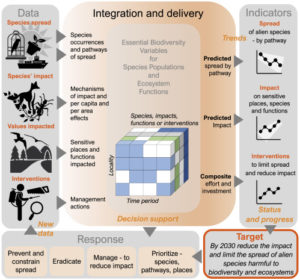Invasive species are credited with reducing global GDP by 5% (see the article by Dropulich), but it is difficult to get a real handle on the losses they cause. Financial losses are one thing – it is even harder to measure and value environmental losses.
As an example of the latter, a recent paper by Clark & Seewagen shows how an ‘alien plant’ (Japanese barberry) can alter relationships at the bottom of a food web (including reducing the diversity of species present), with profound consequences at subsequent levels.
Rabbits are an example of a species able to influence ecological webs in many ways from the bottom of a food web up; reducing the viability of native plants, increasing the opportunities for weeds to establish, and increasing predator populations.
Such complexity makes it difficult to measure the ‘impact’ of an invasive species so a surrogate, the population and distribution of the species, is often used. A recent paper by O’Loughlin et al looks at ‘previously unappreciated solutions’ to get more quantitative rigour in assessments of the impact of invasive species.
A subsequent challenge is to examine the costs and benefits of control. Hanley & Roberts present examples of non-market valuation methods, and how they can measure public preferences for alternative control options. Difficulties in applying economic valuation methods are also discussed.
In their paper, McGeoh & Jetz discuss the value of integrated data to understand the impacts of, and appropriate responses to, invasive species. Their work is at a global scale, but the logic applied is directly scale-able to local levels.
Valuing the costs and benefits of pest control is a complex and difficult task, but it must be attempted. Understanding and describing the impact of a pest species is an essential first step toward designing fit-for-purpose management regimes, and that is one of the aims of Foundation for Rabbit-Free Australia.
For more information:
- Invasive Japanese Barberry – article by Ed Ricciuti in Entomolgy Today, and paper by Clark & Seewagen (2019) in Environmental Entomolgy.
- Surrogacy: inferring ‘impact’ from ‘invasiveness’ – paper in Frontiers in Ecology and the Environment by O’Loughlin et al.
- Economic benefits of invasive species management – paper in People and Nature, by Hanley & Roberts (2019).
- Improved targets: measure and reduce the harm caused by biological invasions – article in Phys Org by Droplulich, and paper in One Earth by McGeoh & Jetz (2019).

Sustainable knowledge delivery – by McGeoh & Jetz (2019) One Earth.
